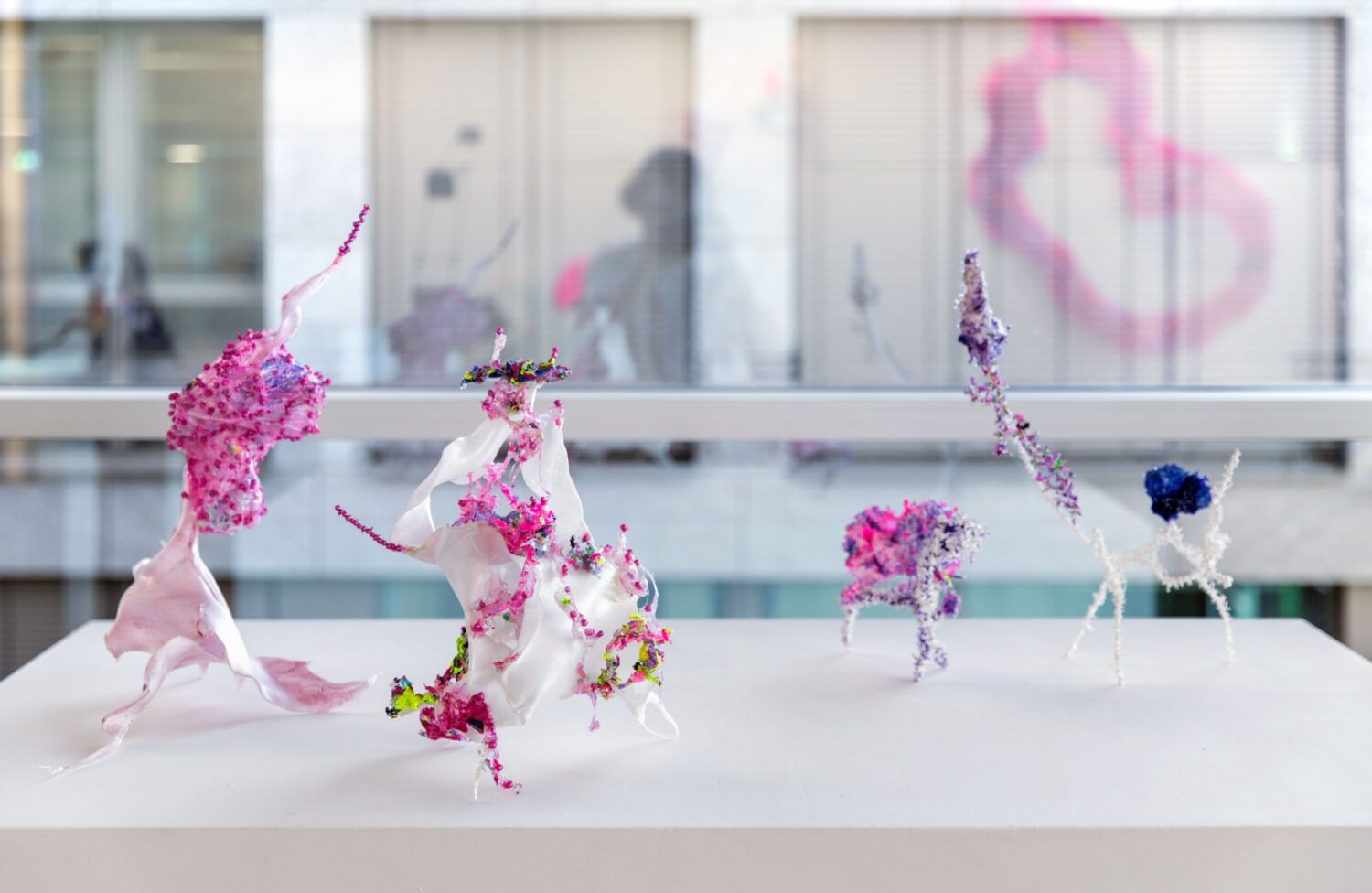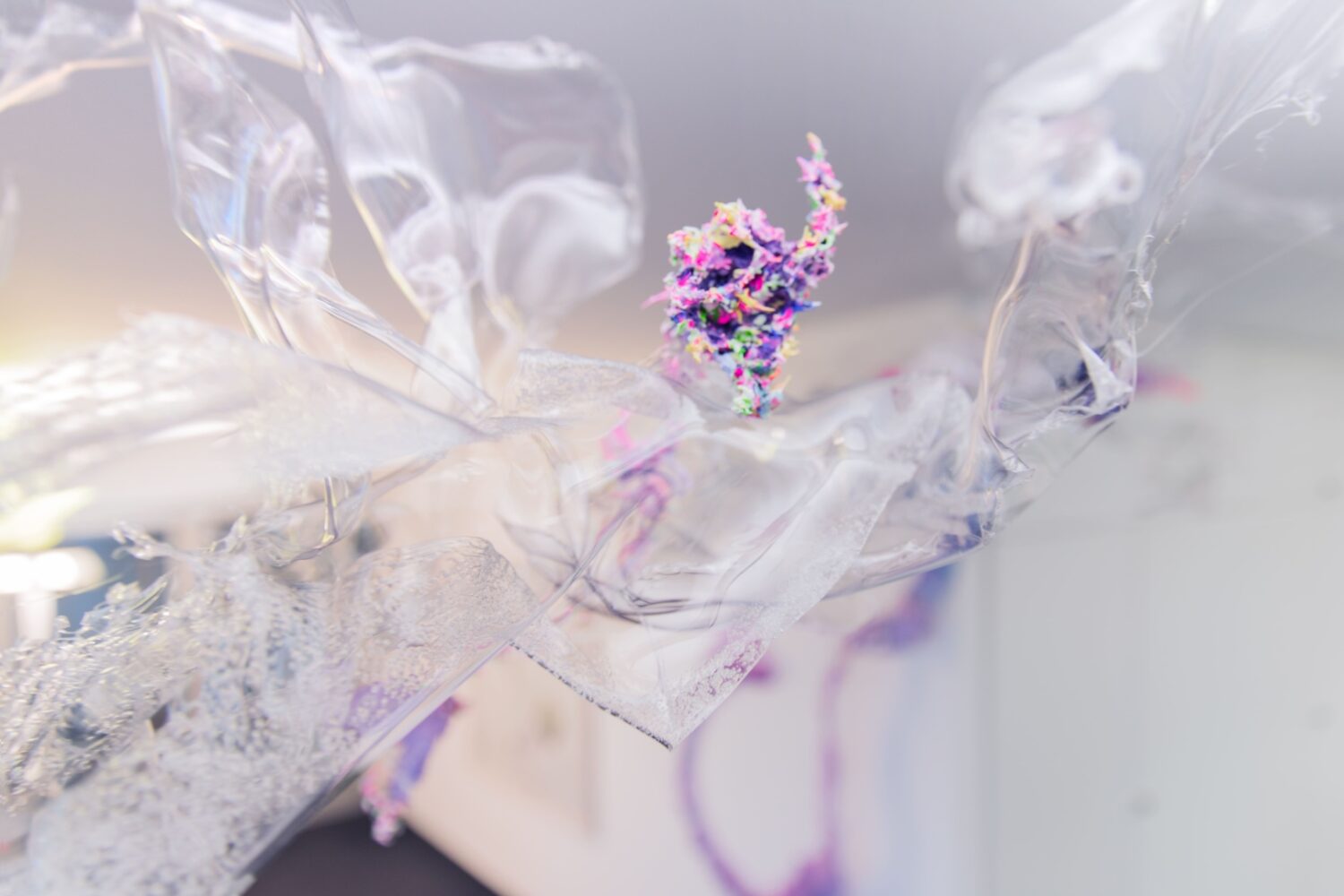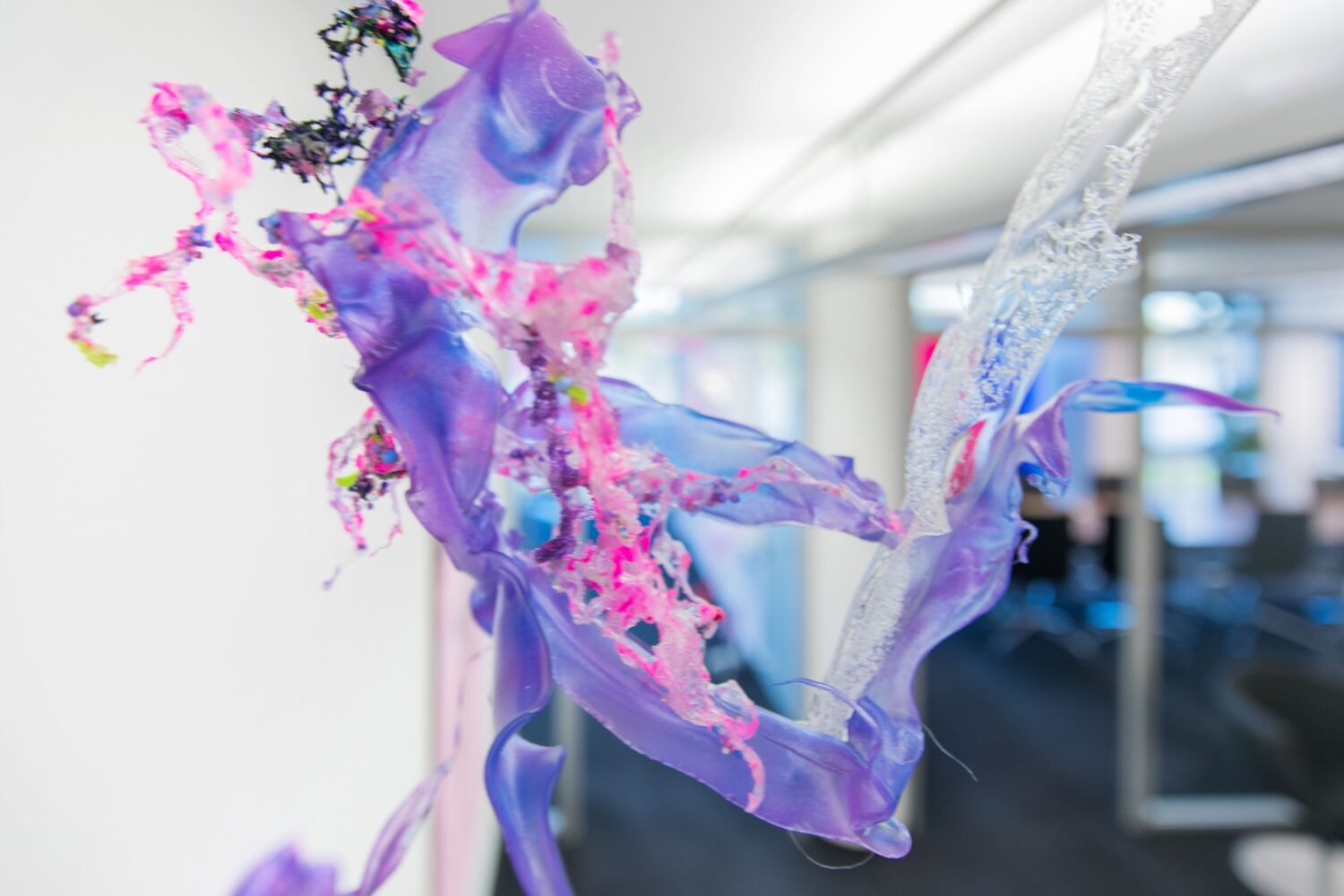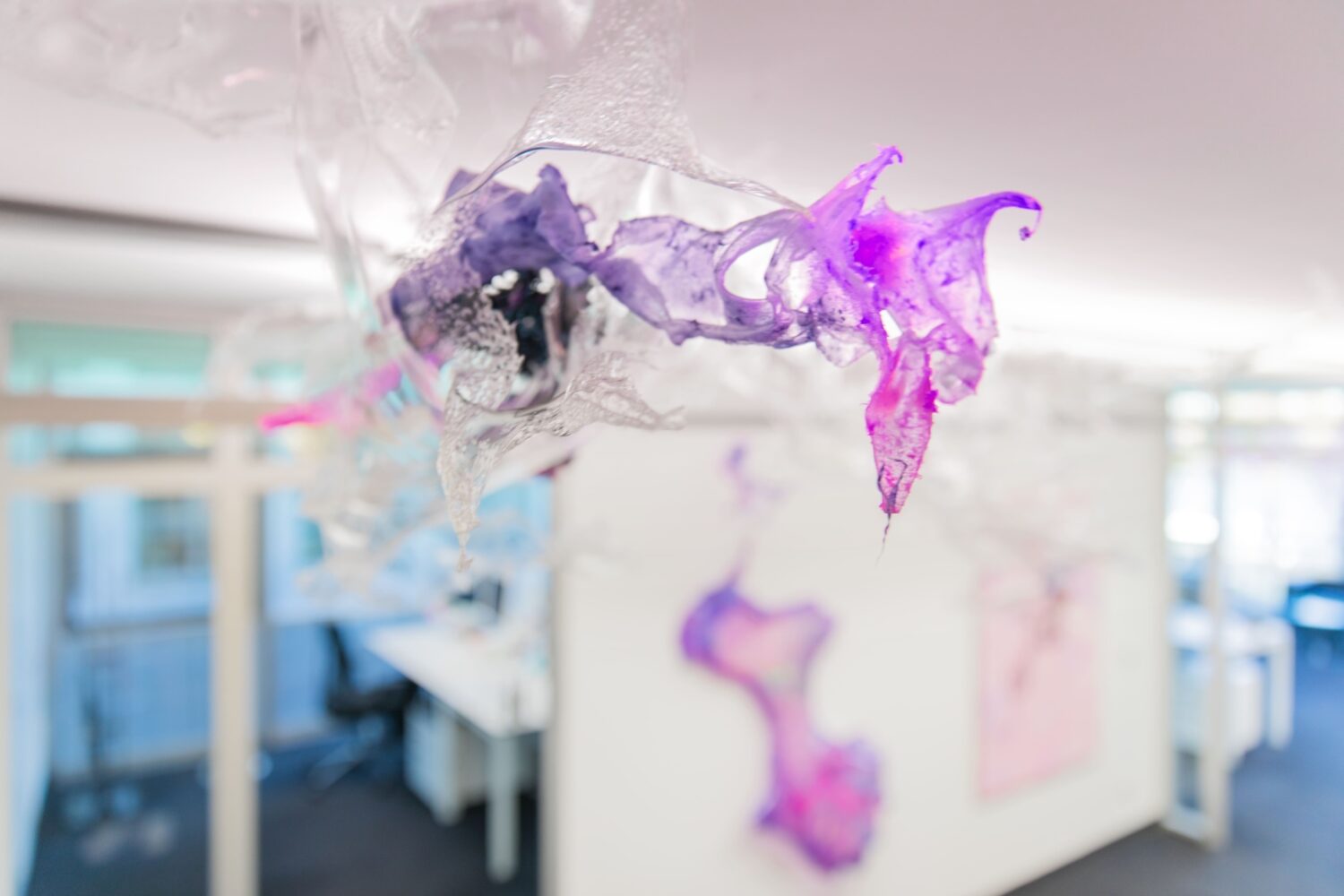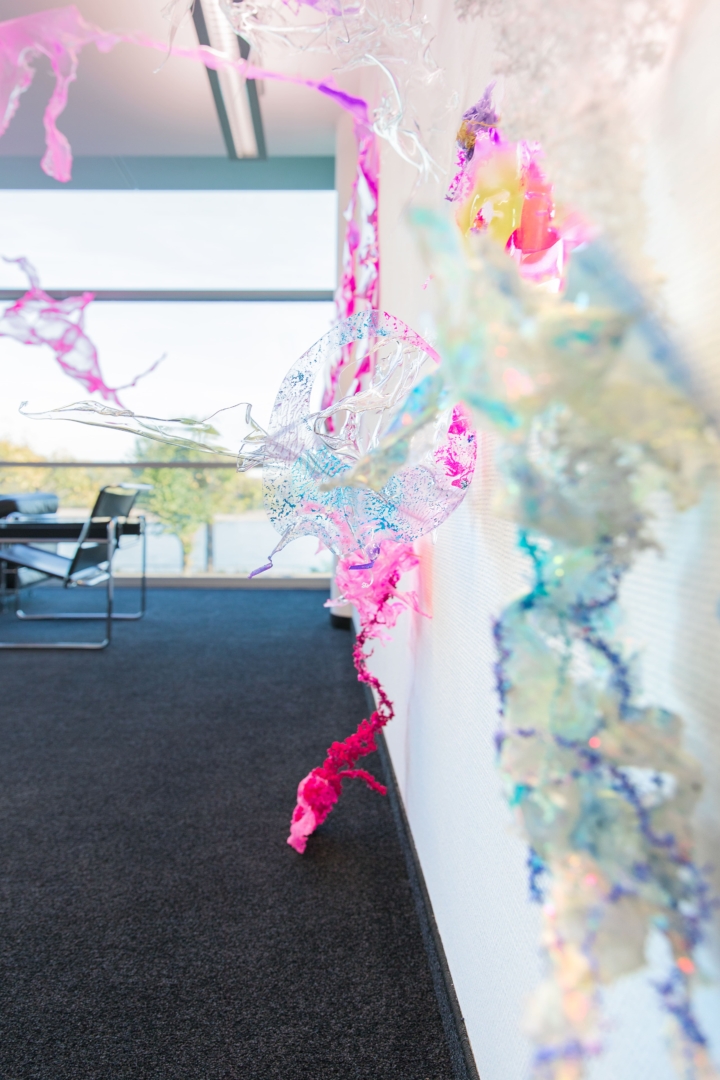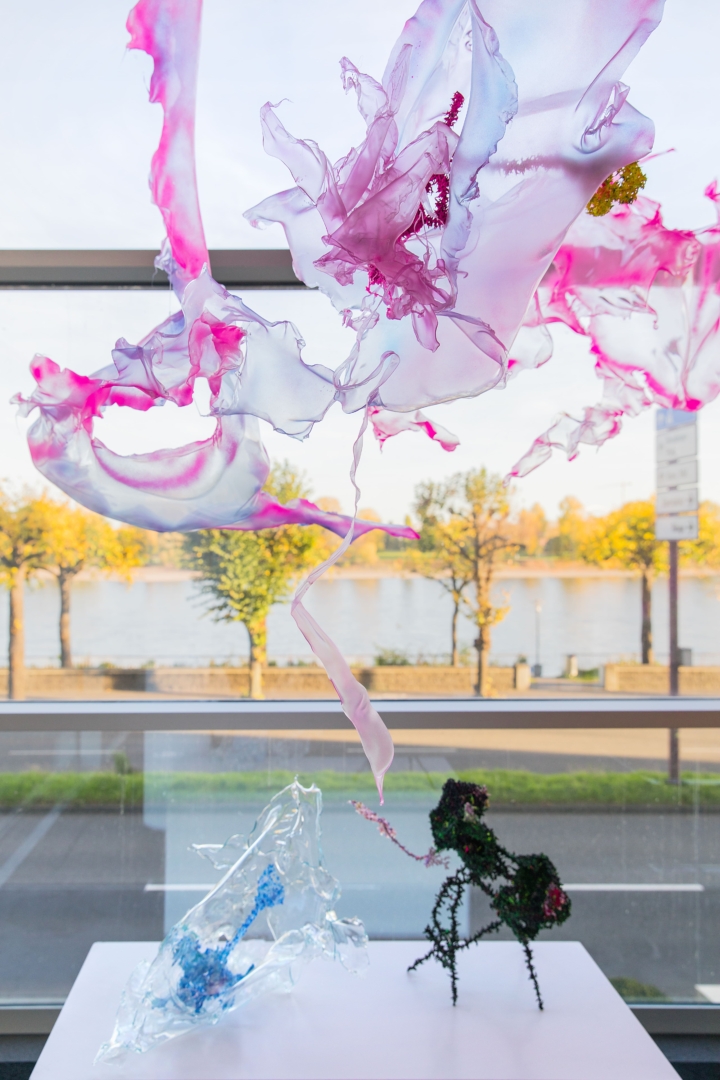PRISKA PASQUER COLOGNE
ALJOSCHA – DISTANT POSTERITY
Opening, Friday, November 11, 2022
November 11, 2022 – January 31, 2022
Priska Pasquer is delighted to be hosting for the first time the Ukrainian artist Olexiy Potupin, aka Aljoscha. In his solo exhibition “Distant Posterity,” he uses new paintings, installations, and sculptures to depict a future vision of the world. It’s populated by new species of creatures that have overcome hatred and violence.
The fantastical objects, sculptures, and landscapes appear strangely weightless and sublime. They set the scene for the unknown, the indescribable that Aljoscha tries to fathom. Driven by the question of how we see our biological future, he incorporates philosophical, ethical, and scientific questions into his artistic exploration. Against this backdrop, he’s developed an anticipatory theory of evolution called “bioism” – a manifesto under which Aljoscha subsumes his artistic work.
Utopian creatures
Having started out in painting, Aljoscha’s work process begins with oil paintings and filigree drawings. He then transfers the visual idea into space and develops a three-dimensional piece. Sometimes it seems to grow out of the canvas in a tangle, at times it meanders through the room like an installation, or alternatively it may unfold a sculptural presence as a creature-like formation. Although the objects’ artificiality is apparent from the use of acrylic, silicone or aluminum, their likeness suggests a natural movement.
Aljoscha’s “p-landscapes” and drawings exhibit organic forms inspired by synthetic biology. Starting from the center of the picture, organisms appear to undergo metamorphosis and proliferate in all directions, creating the impression of three-dimensional depth. However, due to the monochromatic, contourless background, the formations float in a weightless, infinite sphere. Aljoscha describes his works as creature-like utopias. The first such future fantasy, the island of “Utopia,” was developed by the British scholar Thomas More some 500 years ago as a remedy for an exhausted society. He, too, positioned his vision far from reality, amidst the vastness of the world’s oceans.
Aljoscha’s large bioisms are always created in place. Combining various small-scale elements, he intervenes in the local environment. The work “From Panspermia and Primordial Soup to Autopoiesis and Cognition” reflects Aljoscha’s profound, scientific exploration translated into a highly poetic formal language. Here we see the unique quality of his works. The “primordial soup” theory defines amino acids as the basic building blocks of life; the “panspermia” hypothesis assumes that bacterial life was transported to Earth by comets. The installation is intended to help us comprehend mutation as the machinery of life. The translucent Plexiglas creates a dynamic highlighting the fact that genetic information constantly changes. The work thus quickly awakens the fantastical idea that after the exhibition has closed, creature-like forms will permeate the entire gallery like a primordial mass.
Artistic interventions as futuristic messages
Showing his subversive sense of humor, Aljoscha frequently places his idiosyncratic forms in public places or on monuments. Here, too, his interventions highlight the contrast between status quo and artistic vision. They seem like a message of hope from a future, better world.
Dr. Wiebke Hahn
About Aljoscha
Aljoscha was born in the east Ukrainian town of Lozova in 1974. For over twenty years he’s lived and worked in Düsseldorf, where he studied under Konrad Klapheck at Kunstakademie. In 2006, he attended Shirin Neshat’s class at the International Summer Academy of Fine Arts in Salzburg. He was awarded first prize in sculpture at the XXXV Premio Bancaja in Valencia in 2008, and the Schlosspark 2009 sculpture prize in Cologne in 2009. In 2010, he executed the installation project “bioism uprooting populus” with funding from the Karin Abt-Straubinger Foundation in Stuttgart. In November 2018, Aljosha represented Ukraine in the exhibition “1914/1918 – Not Then, Not Now, Not Ever” at the German Bundestag commemorating the centenary of the end of the First World War. His works are contained in many private collections and museums, including the Getty Center in Los Angeles, the Museum of Prints and Drawings in Berlin, and the State Museum of Contemporary Art in Thessaloniki.
Die Galerie Priska Pasquer freut sich erstmals mit dem ukrainischen Künstler Olexiy Potupin, bekannt als Aljoscha, zusammenzuarbeiten. In der Einzelausstellung „Distant Posterity“ [„Ferne Nachwelt“] inszeniert er mit neuen Arbeiten aus den Bereichen Malerei, Installation und Skulptur das futuristische Bild einer Nachwelt. Sie wird von Lebewesen einer neuartigen Gattung bevölkert, die Hass und Gewalt überkommen haben.
Die fantastisch anmutenden Objekte, Skulpturen und Landschaftsbilder erscheinen seltsam schwerelos und erhaben. Sie verorten das Unbekannte und Unbeschreibbare, das Aljoscha zu ergründen sucht. Von der Frage getrieben, wie wir unsere biologische Zukunft sehen, bezieht er philosophische, ethische und wissenschaftliche Fragen in die künstlerische Auseinandersetzung ein. Vor dieser Folie hat er eine antizipierende Evolutionstheorie, den „Bioismus“, entwickelt. Sie lässt sich im Sinne eines Manifests verstehen, unter dessen Programmatik Aljoscha seine künstlerische Arbeit subsumiert.
Utopische Wesen
Ursprünglich von der Malerei kommend stehen Öl-Bilder und filigrane Zeichnungen am Anfang seines Arbeitsprozesses. Von ihnen ausgehend hat Aljoscha die Bildidee in den Raum überführt und sein plastisches Werk entwickelt, das mal geflechtartig aus dem Bildträger zu wachsen scheint, installativ durch den Raum mäandert oder als wesenartige Formation eine skulpturale Präsenz entfaltet. Durch die Materialien Acryl, Silikon oder Aluminium wird die Künstlichkeit der Objekte offenbar, dennoch suggerieren sie durch ihre Leichtigkeit eine natürliche Beweglichkeit.
Die „p-landscapes“ und Zeichnungen zeigen organische Formen, zu denen der Künstler sich von der synthetischen Biologie inspirieren lässt. Vom Bildmittelpunkt ausgehend scheinen Organismen metamorphosenartig in alle Richtungen zu wuchern, wodurch der Eindruck einer dreidimensionalen Tiefe entsteht. Durch den einfarbigen, konturlosen Hintergrund schweben die Formationen jedoch in einer schwerelosen, unendlichen Sphäre. Aljoscha beschreibt seine Werke als wesenartige Utopien. Die erste derartige Zukunftsphantasie, die Insel „Utopia“, entwickelte der britische Gelehrte Thomas More vor rund 500 Jahren als Heilmittel für eine erschöpfte Gesellschaft. Auch er verortete seine Vision weit weg von der Realität, inmitten der Weiten des Weltmeeres.
Aljoschas größere Bioismen entstehen immer vor Ort. In Kombination verschiedener, kleinteiliger Elemente greift er in die örtlichen Gegebenheiten ein. Die Arbeit „Von Panspermie und Ursuppe zur Autopoiesis und Kognition“ spiegelt die tiefgehende, wissenschaftliche Auseinandersetzung Aljoschas wider, die er in eine hoch poetische Formensprache übersetzt. Hier liegt die besondere Qualität seiner Werke. Die „Ursuppen-Theorie“ definiert Aminosäuren als die Grundbausteine des Lebens. Die “Panspermie-Theorie” geht davon aus, dass Kometen bakterielles Leben auf die Erde transportiert haben. Die Installation soll die Mutation als die Maschine des Lebens begreifbar machen. Durch das transluzente Acrylglas entsteht eine Dynamik, die die ständige Veränderung der genetischen Informationen hervorkehrt. Schnell erweckt die Arbeit so die phantastische Vorstellung, dass die wesenartige Formen nach Ausstellungsende gleich einer Urmasse die gesamte Galerie bedecken werden.
Künstlerische Interventionen als futuristische Botschaften
Immer wieder platziert Aljoscha mit subversivem Humor seine eigenwilligen Formen auf öffentlichen Plätzen oder Denkmälern. Einmal mehr verdeutlichen die Interventionen den Kontrast zwischen Status Quo und künstlerischer Vision. Sie wirken wie eine hoffnungsvolle Botschaft aus einer zukünftigen, besseren Welt
Dr. Wiebke Hahn
Über Aljoscha
Aljoscha wurde 1974 im Osten der Ukraine in Lozova geboren. Seit mehr als 20 Jahren lebt und arbeitet er in Düsseldorf, wo er bei Konrad Klapheck an der Kunstakademie studierte. 2006 nahm er an der Internationalen Sommerakademie für Bildende Kunst in Salzburg bei Shirin Neshat teil. 2008 erhielt er den 1. Preis in Skulptur auf der XXXV. Premio Bancaja, Valencia, Spanien und 2009 den Skulpturpreis »Schlosspark 2009« in Köln. Im Jahr 2010 fand das Installationsprojekt »bioism uprooting populus« statt, welches durch die Karin Abt-Straubinger Stiftung in Stuttgart gefördert wurde. Im November 2018 vertrat Aljoscha in der Ausstellung »1914/1918 – Not Then, Not Now, Not Ever« im Deutschen Bundestag, welche zum 100. Mal an das Ende des 1. Weltkrieges erinnern soll, die Ukraine. Seine Werke sind in zahlreichen Privatsammlungen und Museen vertreten, darunter im Getty Center in Los Angeles, im Kupferstichkabinett Berlin sowie im State Museum of contemporary Art in Thessaloniki.

